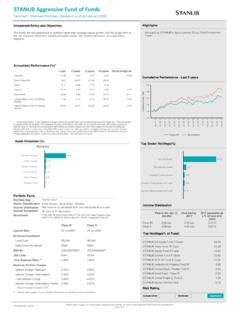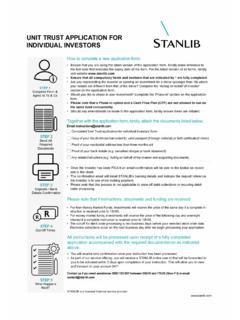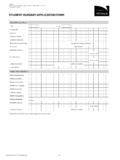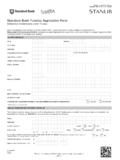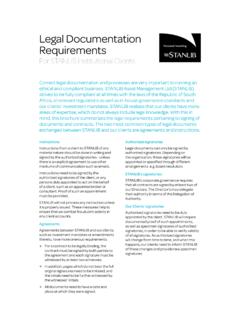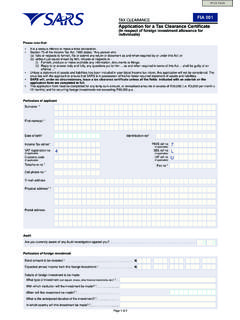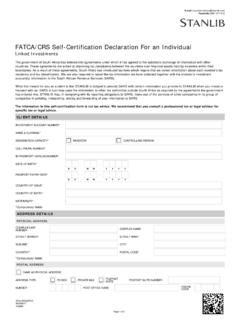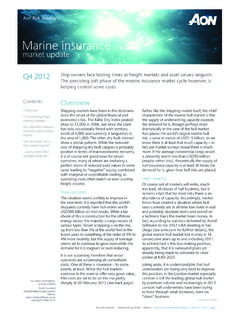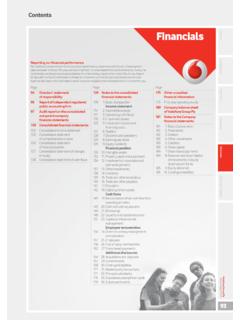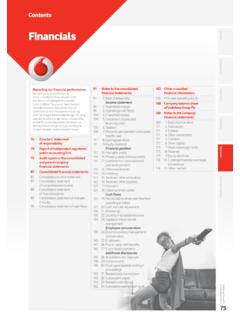Transcription of What are retention funds? - STANLIB
1 Explaining retention funds 9 September 2014. The creation of retention funds or side pockets is not an everyday event. In fact, the rescue of African Bank by the South African Reserve Bank (SARB) and the consortium of investors has introduced a number of firsts within the South African context. It is therefore understandable that retention funds are causing confusion and anxiety among investors. This communication aims to explain the side- pocketing process, why it was implemented, and where to from here. What are retention funds?
2 Side-pocketing is the process of separating illiquid assets from more liquid assets, by allocating illiquid assets to a retention (side pocket). fund . In this instance, an investor's share of the portfolio's exposure to African Bank fixed interest instruments was transferred to a separate portfolio, called a side pocket or a retention fund . Because African Bank shares' value dropped to zero, there was no need to create side pockets for any equity holdings. This therefore only affects funds with fixed interest exposure.
3 The retention funds thus created still belong to the investors this amount has not been written off, just ring-fenced. Adding the two portfolios together (the main holding plus the side-pocket) still gives you 100% of your investment. So side-pocketing is not a reduction in value. The main fund continues to trade, receive contributions, pay out withdrawals and earn interest as it always has. Example: If you have R100 000 invested in a STANLIB ABC fund and this fund had a 5% exposure to African Bank fixed Interest instruments after the write down.
4 This 5% is then transferred into a separate fund , called STANLIB ABC ABIL retention fund . This leaves you with 95%. of your original investment in STANLIB ABC fund , which is still earning and releasing interest; plus your separate STANLIB ABC ABIL. retention fund of 5%, which equals 100% of your investment (post the write-down). Why are retention funds necessary? The African Bank fixed interest instruments are in suspension (not paying interest and not tradable) while the company is under curatorship. It makes sense to remove them from the portfolio and put them into a side pocket until such time as hopefully African Bank is once again able to resume paying interest and, in time, capital back to investors.
5 The main aim of side pocket funds is protection of our investors, both existing and new. It means that new investments will not be exposed to any ABIL assets. It also ensures that existing investors will not be prejudiced by other investors making withdrawals and leaving the remaining investors with a greater share of the untradeable ABIL fixed interest instruments. How do retention funds protect investors? This is best explained with an example. Let's say that the STANLIB ABC fund has R1 000 000 invested in it by multiple investors, and R1000 or is invested in ABIL debt.
6 One of the investors wants to withdraw R100 000. Under normal circumstances, this withdrawal would have been processed as follows: or R100 would be disinvested from ABIL assets, and The remainder, R99 900, would be disinvested from the rest of the assets. Disinvesting means selling the underlying assets for cash. However, ABIL fixed interest assets are not tradable due to the suspension, which means we can't sell the R100 of ABIL assets to pay out this investor. This means that under the current circumstances, the withdrawal would be processed as follows: No amount could be disinvested from the suspended ABIL assets, and The entire R100 000 would need to be disinvested from the rest of the assets (which are liquid and can be sold for cash).
7 1. So after a R100 000 withdrawal, the total balance in the fund is R900 000. Because we could not sell any of the ABIL assets (due to their suspension), the entire original R1000 of ABIL assets is still in the fund . This means that the balance, R899 000, is invested in other assets. The effect of this transaction is that the percentage of ABIL assets in their portfolios has increased to (= 1000/899 000) for all remaining investors. That is, all remaining investors now have a higher exposure to the ABIL assets than they did before the withdrawal.
8 This would not be fair. The retention fund prevents this from happening. It ensures that all existing investors share in the ABIL assets equitably and that withdrawals do not prejudice any clients. It also ensures that any new deposits into the main fund will have no exposure to African Bank. How have retention funds been applied to STANLIB funds? South African Reserve Bank placed African Bank under curatorship on 10 August 2014. The terms of the rescue plan of African Bank has created unforeseen losses for some of our investors and understandable anxiety.
9 On 15 August 2014, the Registrar of Collective Investments issued Guidance Note 6, which outlined a process whereby Collective Investments Scheme Managers could create a retention fund to segregate illiquid ABIL debt assets into a side pocket. This is in line with international best practice and the approach being adopted in the majority across the industry. STANLIB has elected and received approval from the FSB to establish these funds late on Monday, 18 August 2014. All investors invested in funds with fixed interest exposure to ABIL as at 15 August 2014 have ABIL retention Funds allocated as follows: ABIL exposure moved to retention Non-ABIL fund ABIL retention fund fund as at 15 August 2014.
10 STANLIB Aggressive Income STANLIB Aggressive Income fund ABIL retention fund STANLIB Bond fund STANLIB Bond ABIL retention fund STANLIB Enhanced Yield ABIL. STANLIB Enhanced Yield fund retention fund STANLIB Extra Income ABIL. STANLIB Extra Income fund retention fund STANLIB Flexible Income STANLIB Flexible Income fund ABIL retention fund STANLIB Income ABIL. STANLIB Income fund retention fund STANLIB Inflation Plus 5%. STANLIB Inflation Plus 5% fund ABIL retention fund STANLIB Multi-Manager STANLIB Multi-Manager Absolute Absolute Income fund Income ABIL retention fund STANLIB Multi-Manager STANLIB Multi-Manager Balanced Balanced fund ABIL retention fund STANLIB Multi-Manager STANLIB Multi-Manager Flexible Flexible Property fund Property ABIL retention fund STANLIB Prudential Bond STANLIB Prudential Bond fund ABIL retention fund STANLIB Institutional STANLIB Institutional Money Money Market fund Market ABIL retention
